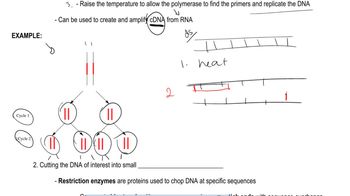What is apoptosis, and under what circumstances do cells undergo this process?
Table of contents
- 1. Introduction to Genetics51m
- 2. Mendel's Laws of Inheritance3h 37m
- 3. Extensions to Mendelian Inheritance2h 41m
- 4. Genetic Mapping and Linkage2h 28m
- 5. Genetics of Bacteria and Viruses1h 21m
- 6. Chromosomal Variation1h 48m
- 7. DNA and Chromosome Structure56m
- 8. DNA Replication1h 10m
- 9. Mitosis and Meiosis1h 34m
- 10. Transcription1h 0m
- 11. Translation58m
- 12. Gene Regulation in Prokaryotes1h 19m
- 13. Gene Regulation in Eukaryotes44m
- 14. Genetic Control of Development44m
- 15. Genomes and Genomics1h 50m
- 16. Transposable Elements47m
- 17. Mutation, Repair, and Recombination1h 6m
- 18. Molecular Genetic Tools19m
- 19. Cancer Genetics29m
- 20. Quantitative Genetics1h 26m
- 21. Population Genetics50m
- 22. Evolutionary Genetics29m
19. Cancer Genetics
Overview of Cancer
Problem C.11c
Textbook Question
Go to the website http://www.ncbi.nlm.nih.gov/omim and enter 'Lynch syndrome' in the Search box at the top of the page. From the list of options given, select '#120435—Lynch Syndrome.' Use the information you retrieve to answer the following questions. Provide a brief summary of the normal functions of the protein products of these genes.
 Verified step by step guidance
Verified step by step guidance1
Understand that Lynch syndrome is primarily associated with mutations in mismatch repair (MMR) genes, which produce proteins responsible for correcting DNA replication errors.
Visit the website http://www.ncbi.nlm.nih.gov/omim and enter 'Lynch syndrome' in the search box to locate the entry '#120435—Lynch Syndrome.'
Review the gene list associated with Lynch syndrome in the OMIM entry, focusing on key genes such as MLH1, MSH2, MSH6, and PMS2, which encode proteins involved in DNA mismatch repair.
Summarize the normal function of these proteins by explaining that they form complexes that recognize and repair mismatched bases or insertion-deletion loops during DNA replication, maintaining genomic stability.
Highlight that the proper function of these proteins prevents accumulation of mutations, thereby reducing the risk of cancer development, which is compromised in Lynch syndrome due to defective mismatch repair.
 Verified video answer for a similar problem:
Verified video answer for a similar problem:This video solution was recommended by our tutors as helpful for the problem above
Video duration:
2mPlay a video:
Was this helpful?
Key Concepts
Here are the essential concepts you must grasp in order to answer the question correctly.
Lynch Syndrome and Its Genetic Basis
Lynch syndrome is an inherited disorder caused by mutations in DNA mismatch repair (MMR) genes. It significantly increases the risk of colorectal and other cancers. Understanding the syndrome requires knowledge of how these gene mutations disrupt normal cellular processes, leading to cancer development.
Recommended video:
Guided course

Genetic Cloning
DNA Mismatch Repair (MMR) System
The DNA mismatch repair system corrects errors that occur during DNA replication, such as base mismatches and insertion-deletion loops. Key proteins encoded by MMR genes recognize and repair these errors to maintain genomic stability and prevent mutations that could lead to cancer.
Recommended video:
Guided course

Repair Pathways
Protein Function of MMR Genes in Lynch Syndrome
Proteins produced by MMR genes, such as MLH1, MSH2, MSH6, and PMS2, form complexes that detect and repair DNA mismatches. Their normal function is crucial for preventing accumulation of mutations; loss of function due to mutations impairs repair, increasing cancer risk.
Recommended video:
Guided course

Proteins

 9:51m
9:51mWatch next
Master Cancer Characteristics with a bite sized video explanation from Kylia
Start learningRelated Videos
Related Practice
Textbook Question
773
views
